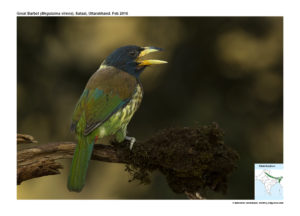Great Barbet

Great Barbet Megalaima virens
Etymology:
- Megalaima: Greek word megalos- great; laimos- throat. { Great Throat}
- Virens: Latin word for Green
Vernacular Names: Hindi: Traiho, H.P: Triho, U.P.: Mewli, Ass: Hetuluka, Cachar: Daokunt laima, Lepcha: Kun nyong, Nepal: Nyahul, Newal.
Distribution in India: Resident in Himalayas and North East of India.
Description: Size of 32–35 cm; wt. of 164–295 g. It is the largest Barbet, with big bill. Both sexes of nominate race are with entirely dark bluish head with some green tones, brown and green body streaked with yellowish below; undertail-coverts are red; bill is yellowish.The immature is similar but duller, sootier, with pink undertail-coverts. The race clamator ( NW and North India) is larger, bluer, darker; other two races paler brown and blue-headed with conspicuous yellow-green nape streaks, race magnificus ( Central Assam)is less marked, race marshallorum ( East of Assam) is palest with blue-violet on head and greatest amount of yellowish nape streaking.
Habitat: It is found in moist, subtropical and temperate forest and well-wooded country. It is found at 800 m–2400 m, but breeds from 300 m – 3000 m, and reaches even sea-level in China.
Food Habits: They eat figs and other fruits, and berries, also flowers of pistachio.During nesting period they are also known to eat Insects and worms. They are usually found in groups in fruit laden trees and creates lot of noise with a repeated call that is monotonous, incessant and far reaching, throughout the day
Breeding Habits: Breeds in period of Feb-Sept. Pre-breeding courtship includes singing and countersigning, simultaneous singing of pair; courtship displays with tail-wagging and head-bowing. The nest is excavated by male and female in dead tree or branch, often on underside of latter. Sometimes old woodpecker hole is used. The Male locates such holes and then starts displaying by flight and calls. The female inspects the nest and once she accept the male, they start doing interiors of the nest using soft materials like leaves, feathers etc. They lay a clutch of 2-5 eggs. Both the parents incubate the eggs and the chicks are born Altricial (with closed eyes and little down feathers). The incubation period is 13-15 days. They are fed insects for faster growth and water content. Both parents do the duty of feeding the chicks. The parents will chew the food first and feed only the pulpy food to the chicks. The chicks are fed throughout the day for 2-3 weeks till they are ready to leave the nest .They clean up the nest at least thrice a day and dispose of the garbage carrying it in their mouth far away away from the nest. This is to avoid giving away the nest site to predators. The chicks fledge within 2 weeks and leave the nest post fledging within 2 weeks.